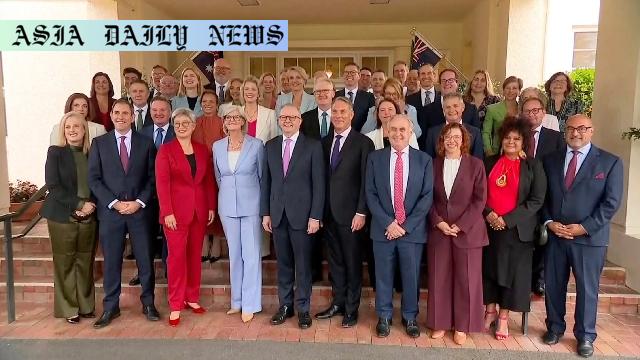Australian PM inaugurated for 2nd term amid new challenges.
Australian PM Anthony Albanese sworn in for the second term.
Key cabinet posts remain unchanged, focusing on security and trade.
Labor Party achieved a landslide victory securing 93 seats.
The PM prioritizes economic ties with China and global diplomacy.
Upcoming trips to Indonesia, Vatican, and Europe underscore efforts towards greater international cooperation.

Australian Prime Minister Anthony Albanese’s Second Term Inauguration
Australian Prime Minister Anthony Albanese was ceremonially sworn in for a second term in office on the morning of May 23, following a significant electoral victory. His Labor Party dominated the general elections on May 3, securing at least 93 seats out of the 150 available in the House of Representatives, as per consistent updates from Australia’s public news service, ABC. This landslide result reflects a strong voter endorsement of Albanese’s leadership and his party’s policies, setting the stage for an ambitious second term for the prime minister and his administration.
Continuity in Cabinet Leadership and Strategic Focus
Key cabinet roles remain unchanged under Albanese’s leadership to ensure stability and consistency in governance. Notable figures such as Deputy Prime Minister and Defence Minister Richard Marles and Foreign Minister Penny Wong continue to hold their prominent positions. This choice underlines the government’s commitment to driving its defense, foreign policy, and economic initiatives with seasoned expertise. Among the core priorities for Albanese’s Cabinet are maintaining robust economic relations with China, Australia’s largest trade partner, while reinforcing security ties with allies such as the United States and Japan.
Diplomatic Agenda: A Focus on Trade and Global Cooperation
Anthony Albanese’s international agenda emerged soon after his swearing-in. He selected Indonesia as his first overseas destination post-election, emphasizing the strategic importance of bilateral relations within the region. This trip will include high-level talks with President Prabowo Subianto to deepen diplomatic understanding and cooperation. Furthermore, Albanese will head to the Vatican to attend the inauguration mass of Pope Leo XIV. Scheduled meetings with European leaders, including European Commission President Ursula von der Leyen, aim to advance Australia’s efforts in securing a comprehensive free trade agreement with the European Union. These engagements illustrate a dynamic vision for Australia’s role in global diplomacy.
Challenges: Economic Prosperity Amid Shifts in US Policy
Despite the celebratory mood of the victory, challenges await Albanese’s administration, especially in economic policy. US trade tariffs initially crafted under President Donald Trump’s administration persist as a thorny issue for Australian exporters. Albanese’s government will have to navigate these policies strategically while seeking to safeguard Australia’s economic interests. His leadership skills and strategy in addressing this key issue could define his second term.
Conclusion: A Renewed Vision for Leadership
Anthony Albanese starts his second term with a clear mandate and a robust policy framework. The combination of strong domestic support, stable governance with an experienced Cabinet, and ambitious foreign policy objectives positions him as a forward-thinking leader for Australia. His focus on fostering regional ties, advancing global trade agreements, and addressing economic challenges showcases his administration’s commitment to building a prosperous and internationally engaged Australia. The upcoming months will reveal how these initiatives unfold and how Albanese’s leadership further solidifies his political legacy.
Commentary
Albanese’s Second Term: Hope for Stability and Progress
The re-election of Anthony Albanese as Australia’s prime minister ushers in a period filled with hope and expectation. His comprehensive win in the general election speaks volumes about the public’s confidence in his leadership, particularly in times of global and domestic uncertainty. Securing 93 seats in the House of Representatives is no small feat and reflects a strong mandate for the Labor Party to govern effectively and decisively.
Expectation from Albanese’s Government
One of the most commendable aspects of Albanese’s approach thus far has been his emphasis on continuity, particularly with key Cabinet roles. By retaining experienced leaders like Richard Marles and Penny Wong, the government has ensured stability in defense and foreign relations during a time of geopolitical shifts. This kind of tactical decision-making indicates an administration that prioritizes expertise and seasoned leadership over experimentation. I believe this decision bodes well for Australia’s position in global affairs, particularly its relationships with the US, China, and neighboring nations.
Challenges and the Road Ahead
Undoubtedly, challenges lie on the horizon. Trade policies, especially those involving the United States, will require deft negotiation. With lingering trade tariffs under the Trump-era policies and shifting global markets, Albanese faces pressure to safeguard Australia’s economic prosperity. At the same time, his tightrope walk of maintaining strong ties with China while collaborating on security initiatives with the US will provide a litmus test for his diplomatic finesse.
Conclusion: Albanese’s Opportunity to Lead
In conclusion, Albanese’s second term offers Australia an opportunity to consolidate its strengths and champion progressive policies on the global front. With his deliberate focus on regional cooperation, trade agreements, and domestic stability, Albanese has set the stage for what could be a transformative tenure. It will be fascinating to see how his leadership evolves over the next few years and whether he can deliver on the burgeoning expectations of the Australian people and the international community.


